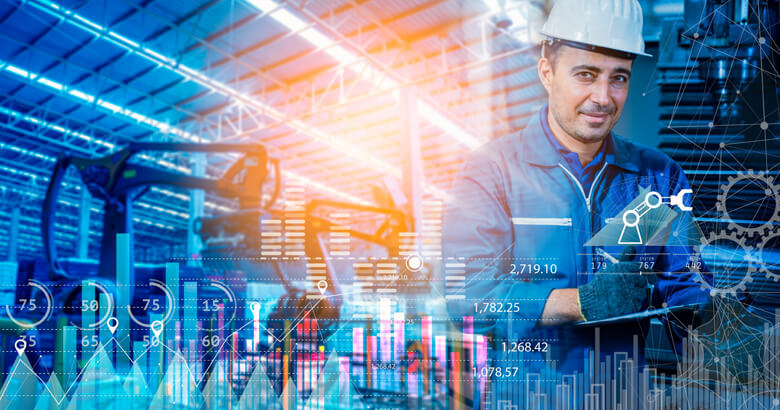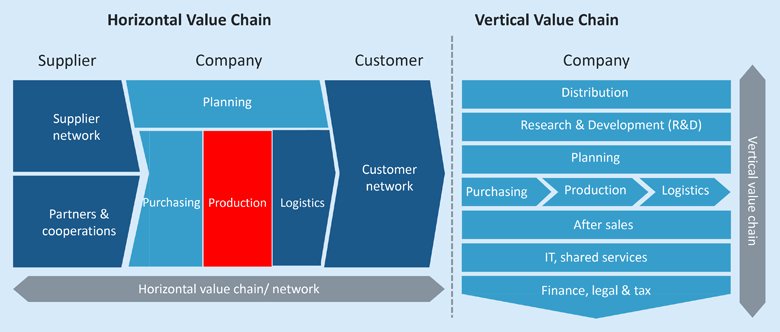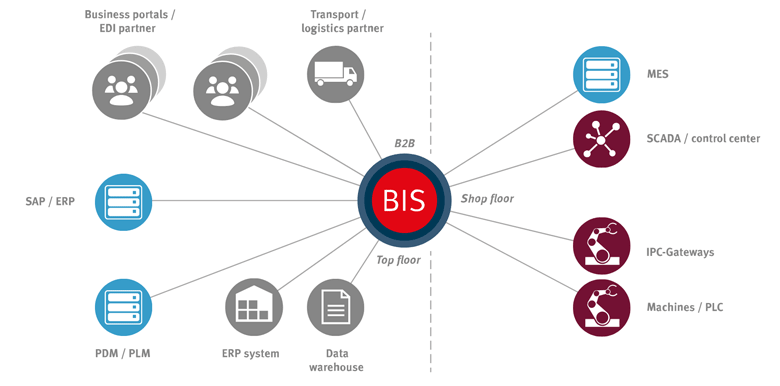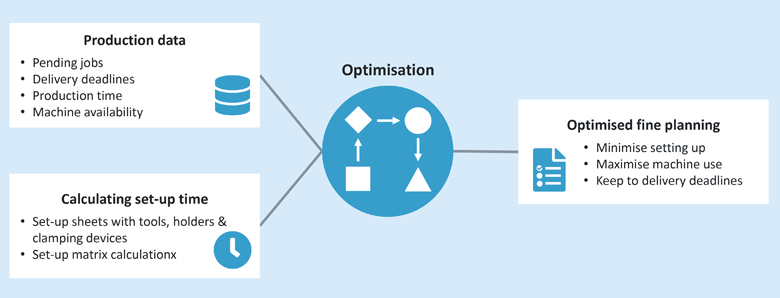Using Real Time Data in Smart Manufacturing

We are currently in the fourth industrial revolution, which is characterised by widespread digitalisation and connecting all manner of machines and devices through the internet. The prevalence of these cyber-physical systems means that everything revolves around real-time data. Indeed, a number of common production processes wouldn’t be possible without this data. Equally, for the first time in history, this gateway to our machines lets us see exactly how our equipment is performing at any one time. This data gives us important insights which we can use to sustainably improve our production processes.
Real time data along the value creation process
Industry 4.0 is characterised by a fusion of manufacturing and information technologies. This opens up whole new ways of organising and managing the entire value creation chain over the full product life cycle, and beyond. At its heart is a constant stream of relevant, real-time data. Once parties in the horizontal and vertical value creation chains are networked, the streams of real-time data mean they have instant access to the information they need to do their work effectively.
 Figure 1: Horizontal and vertical value creation chains
Figure 1: Horizontal and vertical value creation chainsKnowledge is power, and this data can help production managers to powerfully increase the performance and productivity of their systems. Gradually, a company can start harnessing the power of big data, artificial intelligence and machine learning for approaches such as smart services and predictive maintenance to optimise their production lines.
Real time data and cyber-physical systems (CPS)
At the heart of industry 4.0 are cyber-physical systems. A cyber-physical system can be a device, a piece of equipment or a production line. They contain intelligent sensors to monitor the conditions around them. This information is passed down the line, and the machines are able to self-optimise by adapting their performance to the specific job and operating conditions. When several previously standalone cyber-physical systems are integrated, this creates a cyber-physical production system (CPPS). All of this naturally requires access to a constant stream of real-time data. However, integrating the resources and systems involved in a CPPS can be done efficiently and safely with an integration platform such as the SEEBURGER BIS IoT solution.
Generating and processing real-time data in manufacturing
Data is collected from networked machines all the way into the workshop, stored and analysed. The more data that is available, the easier it is to see what is actually going on and how you can further improve the process. You can capture a wealth of data, including:
- The condition and health of the equipment
- the internal temperature when the machine is running
- the noise level
- the revolutions per minute of spinning parts
- the level of vibration
- wear and tear
- The amount produced in a given time frame
- Resource consumption
- Amount of unplanned downtime
- And more.
Real-time data processing not only enables a company to see how well their systems are really performing, it also lets them identify further areas for improvement. The actual values captured by the sensors are compared with target values. Algorithms then trigger certain reactions in real time if threshold values are exceeded or not reached. If the company’s ERP system or other commercial applications are also integrated, certain data values may trigger predictive maintenance measures. Of course, the opportunities afforded by processing real-time data go far beyond just predictive maintenance. You could automate such an integrated system to procure almost any type of real-time production information.
However, for this to happen, the collected data must first flow into a data lake, where it is collated and prepared for big data analysis. One of the main challenges in the systematic use of real-time production data is how to merge disparate data sources into an optimal data stream to provide all your important systems with the right information at the right time.
In order to make decisions based on real-time data, production systems must be able to communicate with each other. Machine data can enter other systems in very different ways. Industrial integration, i.e. aggregating and logging industrial process data through integrating heterogeneous data streams, makes this possible. Modern machines have an OPC UA (Open Platform Communication) interface format. Many companies also use ODBC or radio via RFID to exchange data, depending on the application. Essentially, all the elements in a production process, from individual components to complete systems, are described using properties. The way these properties are described varies from language to language. These different descriptions need to be merged into a common format which obeys the communication standards in IoT and IIoT.
The SEEBURGER Business Integration Suite provides seamless system integration to make the data available from all the systems in your production process in real time.
 Figure 2: Processes are integrated to ensure a robust, constant stream of real-time data[1]
Figure 2: Processes are integrated to ensure a robust, constant stream of real-time data[1]
Give your manufacturing a boost by incorporating real time data
The factory of the future will essentially be one big, self-learning ‛machine’. Materials and components will ‛know’ what they are to become and will guide themselves through the production facilities. This requires a multitude of sensors, which measure a range of production-related parameters and transmit the data in real time to an ERP or cyber-physical system, continually optimising production as they do so. Every step in the production process will benefit from the high level of system integration and data consistency.
- Planning and preparation in smart manufacturing
Planning activities such as work preparation are fully automated in Industry 4.0. This helps deal with the challenges posed by ever shorter product life cycles and a high speed to market, as well as the high degrees of customisation and product variants now expected. The trend is increasingly shifting towards bespoke products, otherwise known as one off production. At the same time, highly dynamic market conditions mean that complexity is increasing. The biggest challenge is that as there isn’t the long lead time of traditional mass production, set up and machine calibration need to be automated to keep up to speed. Ideally, a cyber-physical production system will be able to do its own planning. To do this, it needs information. The whole production process needs to be broken down into individual steps and each step linked to a specific product characteristic. Each step, available capacity and operating and environmental conditions need to be described and this information passed to each cyber-physical element in real time. - Minimise changeover time
The smaller the batches, the more often you will need to reprogramme the machines. However, frequent changeovers have a negative impact on production because you cannot manufacture products while the machines are switched off. The key is to plan the production order in such a way that there is minimal disruption between batches. With the number of possible combinations available in most modern production facilities, this is nearly impossible for staff to do well.
This is where artificial intelligence comes in. It is able to quickly calculate the time required to make the necessary changes to the machines for each batch and create an optimum running order to use the machines to their best capacity and still meet delivery deadlines.
 Figure 3: Speed up set-up times by matching the production data to product-specific set-up times (Image source: Cf. Anacision GmbH)
Figure 3: Speed up set-up times by matching the production data to product-specific set-up times (Image source: Cf. Anacision GmbH)Real-time machine data can also be used to minimise set-up processes. One example is in milling. Instead of replacing a worn tool immediately, it can be used to machine an item with more amenable surface properties or with lower quality standards. The ERP system recognises this and assigns appropriate products to be machined before the tool is replaced. To this end, the company saves costs and increases efficiency while still maintaining the necessary quality standards.
- Quality control and planning
An area which particularly benefits from this high level of continuous real-time data flow and system integration is quality assurance. In order to keep throughput times short, it is important to identify and remove rejects as quickly and automatically as possible. Automatic image processing with powerful cameras to identify defects has been a game-changer for quality assurance. The cameras find quality issues quicker than a later visual check by an employee would, which lets you react quicker to the root cause, such as a broken or wrongly-calibrated part. The integrated ERP system is then told how many parts have been rejected. If this number is high, the ERP system triggers a new work order to make up the deficit. Advance planning and scheduling then ensure that the necessary resources are available for on-time delivery. Real time data analytics and ERP integration are essential in this scenario. Equally, if the production facilities report a stoppage, the ERP system redirects following work to other resources or prioritises delayed work over other less urgent orders. This ensures that the products are still finished and sent off on time. Furthermore, the ERP system also automatically requests maintenance work from certain employees or external providers, where it details the work needed and classifies the urgency.
Let professional data integration solutions make the most of your real time data
The ability to efficiently and effectively use real-time data to optimise production is the trigger for many digitalisation projects. SEEBURGER AG is proud to be a driver for digital transformation and enables its customers to digitalise and integrate internal and external business processes – on-premises or as a managed service/cloud solution. The backbone of this technology is the SEEBURGER Business Integration Suite – a central, company-wide data hub for all your organisation’s integration needs and for secure data transfer.
We would love to advise you on the added value that an integration platform gives to your production facilities. From integrating the shop floor into your business processes, to integrating suppliers’ digital services, to performing data analytics and even making money from it, we believe in the opportunities digital transformation opens up for the manufacturing industry. We are passionate about particularly helping more established companies in various sectors to seize these opportunities and stay ahead of their younger, digital competitors!
[1] PDM = product data management, PLM = product lifecycle management, MES = manufacturing execution system, SCADA = supervisory control and data acquisition, IPC = interprocess communication, PLC = programmable logic controller
Source: https://blog.seeburger.com/using-real-time-data-in-smart-manufacturing/
 industry-trend6.com
industry-trend6.com
